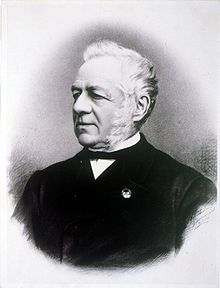Baric wind law
The Malabar Wind Law (also Buys-Ballot Rule ) by Christoph Buys Ballot states that the vast winds that of high pressure - in areas of low pressure blowing, on the northern hemisphere of the earth to the right and on the southern hemisphere are deflected to the left.
The reason for this is the Coriolis force . It has the effect that any mass not moving parallel to the axis of rotation of the earth in the northern hemisphere is deflected to the right. The air masses flowing into a low pressure area therefore rotate to the left, the air masses flowing from a high pressure area to the right. In the southern hemisphere it is exactly the opposite.
The large-scale winds ultimately blow almost parallel to the isobars and can be calculated to a few percent according to direction and strength from pressure differences and positions.
The Baric Wind Law can be summarized as follows: "Near the surface of the earth, an observer who turns his back on the wind, in the northern hemisphere has high pressure on the right and a little behind him, and low pressure on the left and a little in front of him."
With the help of the Baric Wind Law and with some additional knowledge from synoptic meteorology (cyclone model), the interested layman can already draw his own first meteorological conclusions. By observing the cloud formations, the air temperature on the ground, the air pressure and the wind speed, the general weather situation can be estimated quite well . If, for example, an observer stands with the wind at his back and observes falling air pressure and comparatively mild temperatures with increasing wind speed, he can assume that he is in the warm sector of a cyclone. If he also observes the cumulus clouds gathering behind him , he can expect a cold front to arrive shortly . If, on the other hand, he perceives a clearing sky, low temperatures and rising air pressure, the cold front has already passed through.
literature
- Joachim Blüthgen: Textbook of General Geography. General Climate Geography , Volume 2, 3rd, revised edition by Wolfgang Weischet , Berlin, New York 1980 ( Walter de Gruyter ) ISBN 3-11-006561-4
- Katja Bammel, Angelika Fallert-Müller, Ulrich Kilian, Sabine Klonk: The Brockhaus Weather and Climate: Phenomena, Forecast, Climate Change . Brockhaus, Mannheim 2009, ISBN 978-3-7653-3381-1 . (P. 35)
Individual evidence
- ↑ Joachim Blüthgen: Textbook of General Geography. General Climate Geography , Volume 2, Berlin, New York 1980, p. 366

